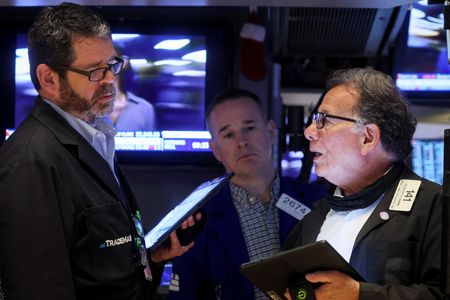
By Caroline Valetkevitch
NEW YORK (Reuters) – U.S. stocks fell on Wednesday as Treasury yields rose above the psychologically important 3% level and oil prices jumped, fanning worries about inflation and the outlook for interest rates.
The S&P 500 ended down more than 1% in the broad sell-off, snapping a two-day winning streak.
Among its biggest drags, shares of Intel Corp slid 5.3% after Citi cut its estimates on the chipmaker for the second time in a week. Citi pointed to uncertainty about demand for personal computers and predicted the company could pre-announce weaker-than-expected earnings for the second quarter. Other chip shares also fell.
Brent crude oil prices rose above $123 a barrel and hit a 13-week high, while the Dow Jones transportation average fell 3.8%, significantly underperforming the other main indexes on the day. The S&P 500 energy sector was the only sector to end higher.
“The 10-year Treasury yield is up over 3%. That’s probably part of why we’re seeing the drawdown in the market today,” said Robert Pavlik, senior portfolio manager at Dakota Wealth in Fairfield, Connecticut.
“That level is what people are focused on because it represents an increase in interest rates and a reflection of inflation and market volatility.”
U.S. benchmark 10-year Treasury yields rose after the U.S. Treasury Department saw tepid demand for a sale of 10-year notes. Rising interest rates tend to be a negative for stocks.
The Dow Jones Industrial Average fell 269.24 points, or 0.81%, to 32,910.9; the S&P 500 lost 44.91 points, or 1.08%, to 4,115.77; and the Nasdaq Composite dropped 88.96 points, or 0.73%, to 12,086.27.
Investors are also cautious ahead of U.S. consumer price data on Friday morning. The report is expected to show that inflation remained elevated in May, though core consumer prices – which exclude the volatile food and energy sectors – likely ticked down on an annual basis.
The U.S. Federal Reserve is expected to raise rates by 50 basis points at each of its June and July meetings, with a similar move also likely in September, in an effort to combat inflation.
Declining issues outnumbered advancing ones on the NYSE by a 2.78-to-1 ratio; on Nasdaq, a 1.33-to-1 ratio favored decliners.
The S&P 500 posted three new 52-week highs and 29 new lows; the Nasdaq Composite recorded 36 new highs and 70 new lows.
Volume on U.S. exchanges was 10.62 billion shares, compared with the 12.26 billion-share average for the full session over the last 20 trading days.
(Additional reporting by Devik Jain and Mehnaz Yasmin in Bengaluru; Editing by Arun Koyyur, Aditya Soni and Jonathan Oatis)

